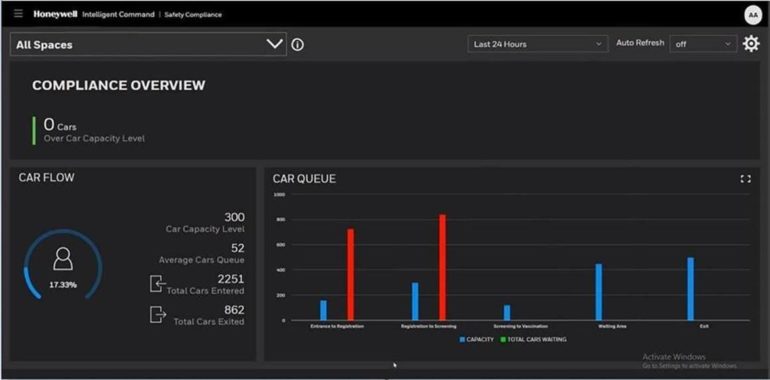Honeywell is in the middle of a grand experiment to create a playbook for mass COVID-19 vaccinations via continual improvement and events that will rely on a bevy of technologies such as the industrial Internet of things.
With partners Atrium Health, Tepper Sports & Entertainment, and Charlotte Motor Speedway, Honeywell is working with the State of North Carolina to distribution 1 million COVID-19 vaccinations by July 4. The public-private partnership, which is now on its second pilot launching mass vaccinations at Bank of America Stadium in Charlotte, NC, highlights the moving parts behind the vaccination effort.
Vaccine management is a hot space as Workday, Salesforce, Microsoft, and ServiceNow rush offerings to the market. The idea is that existing enterprise platforms can be used to bridge data silos and legacy systems. But software only goes so far. Vaccine distribution creates new issues with everything from the supply chain, logistics, and people management.
Must read:
The North Carolina vaccination effort also highlights another trend. Digital and business process transformation are becoming increasingly intertwined and will require continuing tweaking.
We caught up with Taylor Smith, CMO of Productivity Solutions & Services at Honeywell, to check in on the public-private partnership and lessons from the mass vaccination pilots.
Here are some lessons from the mass vaccination effort to ponder.
Know the customer experience today and tomorrow. Smith said there were multiple systems to connect, but the first thing needed was a simple walkthrough. Smith said:
The first step that we took was to do what we call site walk-throughs. So as soon as we found out about this opportunity, we went onsite to a number of Atrium existing vaccination clinics just to see what is the process that they’re going to have to follow to scale up at these large facilities.
The next pilots will inform how drive-through vaccinations and walk-ins simultaneously will work.
Honeywell’s system for monitoring the car queue for COVID-19 vaccinations. Source: Honeywell
Break processes down into components. Smith said:
There are several key areas to break down. One is the patient appointment scheduling and a pre-check in registration to do as much as you can before you get to the site. The second is really looking at the logistics of progressing them through the site and expediting that vaccination. The third area is how you can accurately and efficiently get that data into the state systems and other master systems of records.
Use IT’s 80/20 rule. Customize as needed but don’t go overboard. Smith explained:
We leveraged a lot of the existing systems and solutions we had, but there’s obviously some configuration or optimization for the specific use case. One example is a solution that we have from our building technologies called Pro-Watch. It’s artificial intelligence based video analytics. We provided the cameras and the intelligence software behind that to monitor traffic flow.
As cars are pulling up in the drive-through clinic, we’re now able to detect wait time, queue time, looking at where there were bottlenecks. Then we would dynamically change that throughout the weekend on where do we need more lanes, where do we maybe need a different checkpoint to increase processing time? So that’s just one example of where we’re using existing technology and just tweaking it a little bit to really solve the purpose at hand.
Special feature
The Rise of Industrial IoT
Infrastructure around the world is being linked together via sensors, machine learning and analytics. We examine the rise of the digital twin, the new leaders in industrial IoT (IIoT) and case studies that highlight the lessons learned from production IIoT deployments.
Read More
Be prepared to continually discover gaps and fill them. Smith said Atrium had a robust internal medical record system that had the data the state needed to capture. The state created a new system to capture and aggregate vaccine demand. The problem? There was no mass import capability and the systems relied on manual data entry in a Web form. That approach didn’t scale and required a new approach.
Smith said:
When you’re processing 1,000s and 1,000s of patients a day, that can get very intensive on the backend data entry of having several people or several dozen people really keying in information.
So that was one area that we identified a bottleneck for processing. We came out with an automated barcode scanning solution that really took that patient entry time from five to 10 minutes down to under a minute for Atrium and their workforce over that weekend. That was one big aha moment is how to provide that data processing faster.
Iteration isn’t going to end. Smith said:
The way that we drive iteration is don’t expect perfection the first time but get something out there that you can test. It wasn’t testing for the massive vaccination. It was okay, we found out on Friday, let’s develop and iterate over the weekend jointly with Atrium. They are a great partner. And get something where they can test in their small clinics on Monday. We did that, and we found some stuff that was wrong, and didn’t quite load the data properly, or didn’t quite perform the analytics correctly.
We iterated Monday, Tuesday, Wednesday to a point where we had a really successful go live on Thursday. Continued to make improvements, so by the end of the weekend, we were even driving more efficiency and exceeding the throughput by 7% or 8% at the Speedway than the original target.
ZDNET’S MONDAY MORNING OPENER
The Monday Morning Opener is our opening salvo for the week in tech. Since we run a global site, this editorial publishes on Monday at 8:00am AEST in Sydney, Australia, which is 6:00pm Eastern Time on Sunday in the US. It is written by a member of ZDNet’s global editorial board, which is comprised of our lead editors across Asia, Australia, Europe, and North America.




